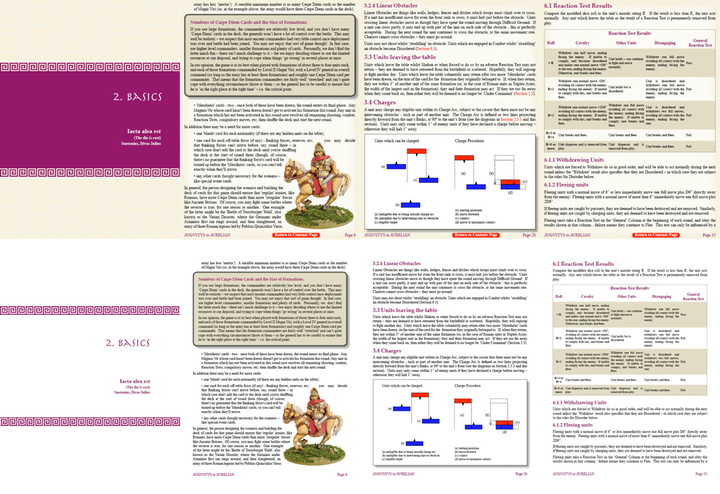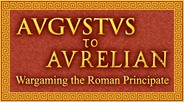The AVGVSTVS to AVRELIAN Blog
Saturday is...
...Launch Day!!
To the accompaniment of a loud fanfare of cornua (trumpets!), I am pleased to announce that, following high-level discussions with Rich (well, he is 6'4", so they were bound to be high-level!) †AVGVSTVS to AVRELIAN will be available to buy from this coming Saturday (2nd June) from the Too Fat Lardies website. †Assuming, of course, that Lard Island doesn't suffer some sort of Krakatoa-like catastrophe in the meantime - in which case, presumably, I'd have to think again!
I hope it isn't significant, but it will be the anniversary of the Vandals sacking Rome… †Not very auspicious!
By the way, we tend to refer to AVGVSTVS to AVRELIAN (which is horrid to type!) as A2A. †I may well slip into doing this when referring to the rules in public - just so as you know!
Sample Pages
Here are four sample pages from each version. †The top line is pages from the tablet version, the bottom row is pages from the printable version. †The main differences are that the printable version has wider margins and doesn't have a coloured background.

Purchasing AVGVSTVS to AVRELIAN *Updated 28/05/12
As I type this, on 21st May, 2012, AVGVSTVS to AVRELIAN isn't available for purchase yet. †That's because I haven't decided yet how I'm going to sell it. †It won't be 'hard copy', it will be a downloadable PDF. †You will probably be able to buy it in three versions:
1) iPad/Tablet version (7.4MB), priced at, probably £12;
2) Printable Version (9.5MB), priced at, probably £12;
3) The complete package (15.8MB) (for completists and those unable to decide which version they'd prefer) - containing all of the above, priced at, probably £16.
Each version contains all that you need to play, except for a table, terrain, figures and dice. †The rules, army guides, QRS, rosters sheet, round sequence cards, order chits, and markers are all included to print out, together with a sheet of 'hints and tips' on what I've found to be the most effective way to print out each item, and some brief instructions on using the iPad/Tablet version.
As I edit this, on†23rd May, 2012, it's looking increasingly likely that†AVGVSTVS to AVRELIAN will be available for sale from the Too Fat Lardies website. †Hopefully, we'll conclude negotiations early next week and then, all being well, it should go live shortly thereafter.
Watch this space for more news!
28th May, 2012
I have just concluded what might be termed negotiations with Richard Clarke (but was really mostly a lot of banter and laughter), and am pleased to announce that AVGVSTVS to AVRELIAN will be available to purchase from the Too Fat Lardies website from this coming Saturday (2nd June).
Welcome!
Welcome to this new blog. †This is 'home' to AVGVSTVS to AVRELIAN, at least temporarily. †Without further ado, let's get stuck in. †I expect you've come here because you want to know more about†AVGVSTVS to AVRELIAN, so here's an introduction to the game.
Philosophy†
I wanted a game with a definite 'period flavour'. Too many sets of 'ancients' rules set out to cover a wide swathe of history and, in so doing, become rather bland' - in many sets, Norman knights turn out to be not all that different from Alexander's Companions. I don't like that - I like particular armies to have their own particular flavour, and that is more easily achieved by writing a set of rules aimed at a specific, restricted, time-period. I chose the period spanning from the accession of Augustus to the death of Aurelian (and probably a few years either side!) because, arguably, the Roman army was organised, and fought, in more or less the same manner throughout that era.†
I wanted a set of rules which emphasised command and control and the 'fog of war'. I happen to like the TooFatLardies' approach, with their 'Big Men', and card-driven round sequence. The emphasis of the game is very much on the role of the 'Big Men'. Deployment is probably the last time you have total control over your army. From then on, circumstances (in the form of the turn of the cards) can often try to derail your plans. The skill lies in having your 'Big Men' in the right place at the right time. Spotting the critical point, and being there when you need to be, can make all the difference between winning and losing.†
And how does your 'Big Man' act? Does he grab a shield, and shoulder his way into the front rank - setting a great example to the men in the unit he's joined (but thereby giving up any semblance of control over the rest of the force under his command), or does he 'stand off' and control all his units? There will probably be a time and place when each approach is the right one - it's up to you to learn when those times are!
Basing
Figure scale doesn't matter - the game will work, possibly with a little bit of thought, and some tweaking (hints given in one of the appendices), with figures of any of the usual scales, from 6mm to 28mm. As for basing, that doesn't matter. I enjoy rebasing about as much as I suspect I'd enjoy sticking rusty pins in my eyeballs, so the need to rebase was one of those things I wanted to avoid absolutely.†
The game is based on units, and you need to be able to distinguish between four sizes of unit - Tiny, Small, Medium and Large. So long as your basing scheme allows you to 'construct' units of easily distinguishable sizes, you'll be fine. Impetus basing might cause slight problems in the area of units sizes, but in that case, my inclination would probably be to ignore unit sizes and just count all the bases as Small units.†
In my armies, which all use 28mm figures, Tiny infantry units have less than 10 figures, Small have 10-20, Medium have 20-30 and Large more than 30. Tiny cavalry units have less than 5 figures, Small have 5-10, Medium have 10-16 and Large more than 16.
Army Guides
First off, I don't 'do' points (for reasons I won't go into in detail here - suffice it to say that I think they merely give the illusion of providing fair games), and so I don't do 'equal points' battles. I'm not interested in that. If that's your thing, these rules probably aren't for you. I'm probably shooting myself in the foot, but I'm also not too keen on 'spoon-feeding' folks too much - you probably need to do a bit of reading for yourself (and a fairly extensive bibliography is provided - so you can work out for yourself whether you agree with my interpretations of the evidence).†
Having said that there are no points, it doesn't take many games to assess what forces will give a good game. We've found that lots of games are actually more fun if the sides are uneven - 'winning' then becomes a case of the smaller/weaker force achieving some limited objectives, whilst the larger force tries to crush them before achieving those aims. Scenario ideas are provided.†
Having said that, 'army guides' are provided. These consist of a short (sometimes very short!) 'potted history', and sometimes (where there is some real evidence available) hints on army composition. In addition, each guide gives a profile for each possible troop type in the army - covering shooting, combat, morale, etc.†
Guides are provided for five Roman armies: Early Imperial 25BC - AD97, Trajanic AD98 - 117, High Imperial AD118-192, Severan AD193 - 235 and Empire in Crisis AD235 - 275. And there are guides for enemies too: Ancient British, Occupied Gaul, Batavian Revolt, Dacia, Early German, Middle German, Alans, Iazyges & Roxolani, Western Arabia, Southern Arabia, Palmyra, Parthia, Sassanid Persia, Jewish - Great Revolt, Jewish - Bar Kochba Revolt, Mauri/Numidians, and Blemmye/Nobades.†
You could use the guides (and their general lack of restrictions on numbers of different sorts of troops) to construct 'killer' armies. But if you're 'that sort' of wargamer, these rules are, again, probably not for you. The guides are aimed at the gamer who wants to construct armies which are historically plausible, and see how they compete with (historically plausible) opponents.
Mechanics
AVGVSTVS to AVRELIAN uses a card-driven round sequence, much like most other ‘Too Fat Lardies’ games. †Each ‘Magnus Vir’ (Big Man) has a card, and when that card is drawn from the deck, it is the turn of the formation he commands to act. †In addition, there are ‘Carpe Diem’ cards which allow a commander to act ‘out of turn’, and also to influence combat or reaction tests. †There are also two ‘Meridiatio’ (lunch-time) cards. †When the second of these is drawn, the round proceeds to its final phase - any remaining shooting, combat and reaction tests take place, before shuffling the deck and starting the next round.
Shooting and combat use the same simple mechanism. †The general rolls a number of D10s (determined by unit size), and compares the roll (modified by a short list of modifiers) against the target’s armour class (of which there are five: None, Light, Medium, Heavy and Cataphract) to generate a number of casualties. †Once the number of casualties exceeds a unit’s ‘Outlook’ (an attribute representing training, motivation, ‘keenness’, etc), that unit is deemed to be ‘Shaken’ and operates at reduced efficiency. †Magni Viri can relieve some of the effects of being ‘Shaken’. †
Units losing in combat, or becoming Shaken must take a Reaction Test. †Reaction tests are performed by rolling two D6s (or picking the best two out of three if a Magnus Vir plays a Carpe Diem card) adding a few modifiers and comparing with a table. †There are a variety of results, ranging from carrying on as normal, right through to the unit dispersing and being removed from play.
What you need to provide
You need to provide: a table and terrain; two armies; at least three six-sided dice, numbered 1-6; at least five ten-sided dice, numbered 0-9; a ruler, or metal tape-measure, marked in inches; a 'scatter' die (only needed if using stone-throwing artillery!).
And that’s pretty much all there is to it...
